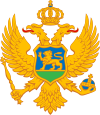
Back اقتصاد الجبل الأسود Arabic Monteneqro iqtisadiyyatı Azerbaijani Черногория иҡтисады Bashkir Эканоміка Чарнагорыі Byelorussian Икономика на Черна гора Bulgarian Economia de Montenegro Catalan Ekonomika Černé Hory Czech Montenegros økonomi Danish Wirtschaft Montenegros German Οικονομία του Μαυροβουνίου Greek
 | |
| Currency | Euro (EUR, €) |
|---|---|
| Calendar year | |
Trade organisations | CEFTA, EFTA, WTO |
Country group |
|
| Statistics | |
| Population | |
| GDP | |
| GDP rank | |
GDP growth | |
GDP per capita | |
GDP per capita rank | |
GDP by sector | Agriculture: 7.5%
|
| 4.3% (2024 est.)[7] | |
Population below poverty line | |
| |
Labour force | |
Labour force by occupation |
|
| Unemployment | |
Average gross salary | €995 / $1053 monthly (August, 2023) |
| €799 / $845 monthly (August, 2023) | |
Main industries | steelmaking, aluminum, agricultural processing, consumer goods, tourism |
| External | |
| Exports | |
Export goods | Copper ore, aluminum, electricity, dried legumes, packaged medicines, lead, scrap iron, lumber |
Main export partners |
|
| Imports | |
Import goods | Refined petroleum, cars, packaged medicines, recreational boats, cigarettes |
Main import partners | |
FDI stock | |
Gross external debt | |
| Public finances | |
| −3.1% (of GDP) (2024 est.):[22] | |
| Revenues | 1.78 billion (2017 est.)[6] |
| Expenses | 2.05 billion (2017 est.)[6] |
| |
 |
| Part of a series on |
| Montenegro |
|---|
| History |
| Geography |
| Politics |
| Economy |
| Society |
The economy of Montenegro is currently in a process of transition, as it navigates the impacts of the Yugoslav Wars, the decline of industry following the dissolution of the Yugoslavia, and economic sanctions imposed by the United Nations. Montenegro joined the World Trade Organization on 29 April 2012.[26] Montenegro joined the North Atlantic Treaty Organization on 5 June 2017.[27] The accession of Montenegro to the European Union is planned for 2025.[28]
- ^ "World Economic Outlook Database, April 2019". IMF.org. International Monetary Fund. Retrieved 29 September 2019.
- ^ "World Bank Country and Lending Groups". datahelpdesk.worldbank.org. World Bank. Retrieved 29 September 2019.
- ^ "Population on 1 January". ec.europa.eu/eurostat. Eurostat. Retrieved 13 July 2020.
- ^ a b c d e f "World Economic Outlook Database". IMF.org. International Monetary Fund.
- ^ "World Economic Outlook Database, April 2020". IMF.org. International Monetary Fund. Retrieved 16 April 2020.
- ^ a b c d e f g h i "The World Factbook". CIA.gov. Central Intelligence Agency. Retrieved 23 January 2019.
- ^ "Estimated inflation rate Montenegro". IMF. Retrieved 2 March 2024.
- ^ "Persons at risk of poverty or social exclusion by age and sex". Eurostat. Retrieved 2 March 2024.
- ^ Europe Central Asia Economic Update, Spring 2020 : Fighting COVID-19. World Bank. 9 April 2020. pp. 61, 62. ISBN 9781464815645. Retrieved 9 April 2020.
- ^ "Gini coefficient of equivalised disposable income - EU-SILC survey". Retrieved 2 March 2024.
- ^ "Human Development Index (HDI)". hdr.undp.org. HDRO (Human Development Report Office) United Nations Development Programme. Retrieved 12 October 2022.
- ^ "Inequality-adjusted Human Development Index (IHDI)". hdr.undp.org. HDRO (Human Development Report Office) United Nations Development Programme. Retrieved 12 October 2022.
- ^ "Labor force, total - Montenegro". data.worldbank.org. World Bank. Retrieved 27 November 2019.
- ^ "Employment rate by sex, age group 20-64". ec.europa.eu/eurostat. Eurostat. Retrieved 25 May 2019.
- ^ "Youth unemployment rate by sex, age (15-24) and country of birth". appsso.eurostat.ec.europa.eu. Eurostat. Retrieved 26 December 2019.
- ^ "Montenegrin exports". CIA. Retrieved 2 March 2024.
- ^ "Export partners of Montenegro". The Observatory of Economic Complexity. Retrieved 14 April 2023.
- ^ "Montenegrin imports". CIA. Retrieved 2 March 2024.
- ^ "Import partners of Montenegro". The Observatory of Economic Complexity. Retrieved 14 April 2023.
- ^ "Montenegrin current account". CIA. Retrieved 2 March 2024.
- ^ "Montenegrin national debt to GDP". Statista. Retrieved 2 March 2024.
- ^ "Montenegro budget balance 2024 estimate". Standard & Poor's. 1 March 2024. Retrieved 2 March 2024.
- ^ "Montenegro rating 2024". Standard & Poor's. 1 March 2024. Retrieved 2 March 2024.
- ^ "Country credit opinion 2023". Moody's. 12 September 2023. Retrieved 2 March 2024.
- ^ "Reserves of foreign exchange and gold". CIA. Retrieved 2 March 2024.
- ^ "Members and Observers". World Trade Organization. 24 August 2012. Archived from the original on 10 September 2011. Retrieved 10 September 2011.
- ^ "Montenegro to Formally Join NATO on June 5 – Independent.mk". Retrieved 6 June 2017.
- ^ "Montenegro Targets 2025 to be Ready for EU Accession". Balkan Insight. 2021-03-26. Retrieved 2021-04-12.
© MMXXIII Rich X Search. We shall prevail. All rights reserved. Rich X Search